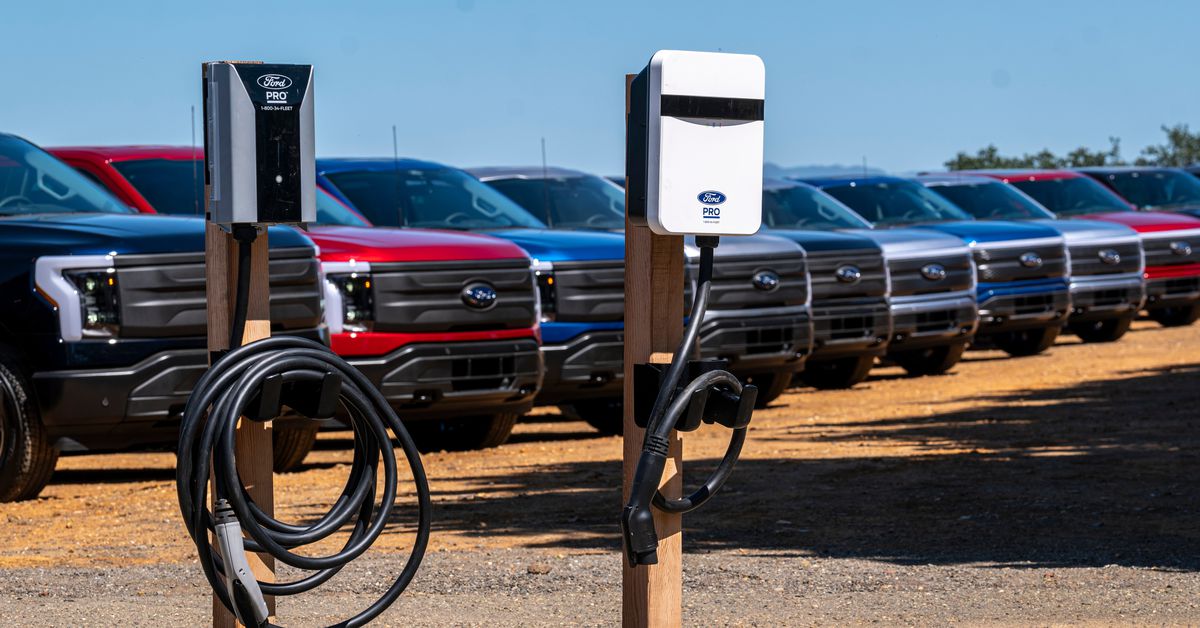There’s a wonky new attempt to use controversial technology to tackle climate change: turning carbon offset credits into crypto tokens. Both carbon offsets and crypto are hot-button topics in the sustainability game. Crypto mines have been notorious sources of climate pollution, and purchasing carbon offsets is a popular way companies try to absolve themselves of their greenhouse gas pollution, a strategy that has mostly failed in the past. Now, parts of the crypto industry are claiming that they can make offset credits better — but experts are still skeptical.
To understand how these new tokens are an old-fashioned carbon offset in crypto clothing, we need to get down to the basics of how they work. We’ll start with carbon credits.
Carbon credits 101
Carbon dioxide is a byproduct of doing business in our current economy, and it will remain in that position as long as we rely heavily on burning fossil fuels. Using electricity, transporting people and goods — all result in carbon emissions that are heating up our planet. This is bad. Now, there is a solution to stop Earth from turning into a charred and flooded hellscape — stop emitting so much carbon dioxide. But that is very inconvenient for companies and requires them to change how they power their operations and move stuff around the world. Some companies think they’ve figured out a way to get around all that. If they keep emitting but want to be able to say that they’re going “green,” they can just invest in efforts to prevent or capture carbon dioxide emissions elsewhere. That will cancel out the effects of their own pollution, or so the thinking goes. Now, people have to figure out how to keep track of that carbon.
That’s where carbon offset credits come into the picture. A carbon credit represents a metric ton of carbon dioxide that’s been captured or that has otherwise avoided being leaked into the atmosphere. Carbon credits have been used for a long time by companies and individuals interested in offsetting their emissions. An airline or one of its passengers, for example, might purchase carbon credits to offset the pollution from a flight, in the process absolving travelers from the stain of climate pollution.
But if this all sounds too good to be true, it’s because it usually is. We’ll get back to this — but first, the blockchain.
Blockchain 101
The flashy new thing we’re talking about here is turning those credits into crypto tokens, which involves bringing the credits that we talked about above onto a blockchain. A blockchain is basically a shared record of transactions, meaning the record is usually maintained by many different people or entities to make it harder to corrupt (The Verge has a great explainer here). That’s important because you want to avoid problems like double-spending with cryptocurrencies or double-counting when it comes to greenhouse gas emissions reductions.
Tying credits to blockchains using tokens, the argument goes, can potentially make it easier to see what the heck is going on in carbon markets. And that’s supposed to make carbon credits more appealing and valuable — which might incentivize better quality offset projects. One of the splashiest examples of this concept is the forthcoming “Goddess Nature Token,” created by a startup called FlowCarbon, whose founders include Adam Neumann of WeWork infamy. The goal of GNT is to usher in “a liquid, transparent market that anyone can access.” In other words, the aim is to make it easier for anyone to buy carbon credits and see how those transactions are taking place.
How helpful that would actually be for the planet, though, is up for heated debate. The elephant in the room is the energy hunger of some blockchains. The biggest culprits are the biggest cryptocurrencies, Bitcoin and Ethereum, that use a particularly energy-intensive and polluting process to verify transactions. Their electricity use can rival the annual electricity use of some small nations. Some of the carbon offsets that have been turned into crypto tokens are available on Polygon, a blockchain that’s essentially built on top of Ethereum. As a result, even though Polygon says it avoids the energy-hungry crypto mining process, it is still responsible for some of Ethereum’s carbon dioxide emissions.
Other tokens have turned to blockchains that use a different system that uses vastly less energy. But this all goes to show that trying to solve climate change through these kinds of techno-fixes is dicey business, with plenty of pitfalls to avoid.
Besides, offsetting emissions the old-school way, pre-crypto, was already a risky venture because a lot of carbon credits on the market are junk: they don’t represent real reductions in emissions. So turning those credits into tokens just doesn’t get to the root of that problem.
“If cryptocurrencies are buying up poor quality credits and tokenizing them and creating value out of them, that seems really problematic to me,” says Barbara Haya, director of the Berkeley Carbon Trading Project. “You don’t want to create value out of things that are based on false claims about carbon impact.”
Carbon offsets 201: the quality control problem
Carbon registries issue carbon offset credits from offset projects that are supposed to reduce the concentration of carbon dioxide building up in the atmosphere — say by preserving a forest or planting trees that draw down planet-heating CO2.
The problem is that carbon offset markets are riddled with bad credits. They might represent, for example, efforts to preserve a forest and its potential to store CO2. Oftentimes, investigations have found, those forests were never in danger of being razed or the threats they faced were exaggerated — so paying to “protect” them didn’t actually help to further limit the amount of planet-heating pollution building up in our atmosphere. In fact, a lot of credits that are traded don’t actually represent real-world reductions in greenhouse gas emissions, the Berkeley Carbon Trading Project has found. Offsetting is “not yet a credible climate solution at all,” Haya says, and the overall quality of offsets hasn’t really improved over time.
Blockchains haven’t solved the quality control problem
There are a lot of companies that are trying to sell crypto as a climate solution. Back in October, a blockchain project called Toucan and a decentralized autonomous organization (sort of like an environmental “crypto co-op”) called KlimaDAO released a new token. It’s called Base Carbon Tonne (BCT), and it represents carbon offset credits that have been moved from a traditional carbon registry onto a blockchain.
Markets for carbon offset markets are “opaque, rife with middlemen and, as a result, suffer from questionable quality and lack transparent price signals,” Toucan said in a post in October when it launched.
Bringing carbon offset credits onto a blockchain theoretically makes the risky process of dealing in carbon credits more transparent. Folks can see the record of transactions clearly on the blockchain: which credits were sold when and for how much, and what kind of carbon-reducing project it stems from.
Toucan’s first effort to bring carbon credits on-chain picked up steam fast. After a few months, about a quarter of all the credits on the world’s largest registry had been moved on-chain using Toucan’s platform. But its popularity didn’t necessarily translate into success when it comes to reducing planet-heating pollution.
One high-profile analysis by researchers at the nonprofit CarbonPlan found that nearly all the credits were of such poor quality that they would have been barred from the global offsetting scheme for international aviation, considered an industry standard for offsets. Part of the problem with many of the credits was that they were tied to old “zombie projects,” according to CarbonPlan, that other buyers likely hadn’t touched because of quality concerns. Once they’d been converted into tokens, all the crypto hype had them selling like hotcakes, even if they weren’t necessarily a good buy.
“There’s plenty of room to over exaggerate how much your crypto efforts are actually helping the environment,” says Grayson Badgley, lead author of the CarbonPlan analysis. “Simply moving that inventory [of credits] from one registry to the next isn’t going to suddenly make those carbon offsets better.”
Backlash to the over-exaggeration was swift. The carbon registry decided to stop turning credits into tokens, pending “public consultation” on how to improve the process. To try to address some of the problems, Toucan introduced a new token called the Nature Carbon Tonne with tighter restrictions on what kinds of offset projects could be included. The critical analysis, they say, proved that blockchain is a tool that can improve the offset market through greater transparency.
“If you can see everything that’s happening, it’s a lot easier to criticize things and to fix things,” says Toucan COO Robert Schmitt. “The only reason CarbonPlan was able to do this analysis is because it’s on-chain. They could never have done this in the traditional market.”
Roadblocks ahead
Neumann’s new venture, Flowcarbon, is trying something similar to Toucan with its Goddess Nature tokens. But it’s trying to avoid some of the problems Toucan ran into by vetting offset credits more thoroughly before turning them into tokens. The tokens will be based on newer carbon credits that meet “market-recognized standards,” Flowcarbon says.
Its promises seem to have reassured investors. Flowcarbon nabbed $70 million in venture capital in May.
Flowcarbon says it plans to officially launch GNT “soon,” refuting a July Wall Street Journal report that said the launch was on hold following crashing crypto prices. “[GNT] will trade at one transparent price for everyone in a liquid, transparent market. This clear and consistent price data is essential for investors to be able to finance new carbon reduction and removal projects that generate credits,” Flowcarbon CEO and co-founder Dana Gibber said in an emailed statement to The Verge.
You see, despite all the documented problems with offsets, they’ve continued to grow more popular as a way for companies to be able to say that they’re shrinking their impact on the environment. Offset fans are holding out hope that the markets can still improve with techno-fixes that have ranged from monitoring offset projects with satellites to make sure they’re doing what they’re supposed to be doing — to blockchains bringing increased transparency to markets. It gives new outfits like Flowcarbon motivation to make carbon credits easier to buy and sell by turning them into tokens.
But experts are dubious that increased liquidity is a good thing, given the poor quality of many carbon offset credits. “Given that you can’t trust the credit quality, companies ideally would do due diligence and really look for projects and project developers that they trust and that they want to support,” Haya says.
The need to vet credits leads to another reason why blockchains haven’t been able to solve problems at the core of carbon offset markets. Digital currency economist Alex de Vries calls it “The Oracle Problem.” Blockchains, by nature of being a decentralized ledger, are — at their best — supposed to eliminate the need to rely on a big institution like a bank to keep an accurate record of assets. But sifting out poor-quality carbon credits still relies on a trusted intermediary like the traditional offset registry. They might need to perform audits to verify that trees actually have been planted and that no one is double counting emissions reductions, de Vries explains.
Otherwise, de Vries says, “If you put garbage on the blockchain, it’s still garbage. The blockchain doesn’t fix that. It’s a misconception.”

 1 year ago
226
1 year ago
226
/cdn.vox-cdn.com/uploads/chorus_image/image/71256858/VRG_Illo_K_Radtke_226132_Carbon_Crypto.0.jpg)





 English (US) ·
English (US) ·